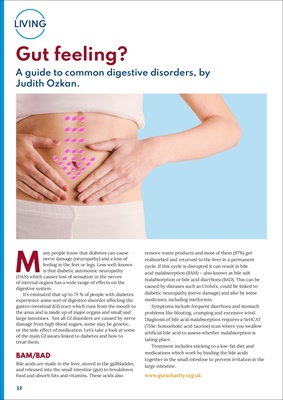
32
LIVING
Gut feeling?
A guide to common digestive disorders, by
Judith Ozkan.
Many people know that diabetes can cause
nerve damage (neuropathy) and a loss of
feeling in the feet or legs. Less well-known
is that diabetic autonomic neuropathy
(DAN) which causes loss of sensation in the nerves
of internal organs has a wide range of effects on the
digestive system.
It's estimated that up to 75 % of people with diabetes
experience some sort of digestive disorder affecting the
gastro-intestinal (GI) tract which runs from the mouth to
the anus and is made up of major organs and small and
large intestines. Not all GI disorders are caused by nerve
damage from high blood sugars, some may be genetic,
or the side effect of medication. Let's take a look at some
of the main GI issues linked to diabetes and how to
treat them.
BAM/BAD
Bile acids are made in the liver, stored in the gallbladder,
and released into the small intestine (gut) to breakdown
food and absorb fats and vitamins. These acids also
remove waste products and most of them (97%) get
reabsorbed and returned to the liver in a permanent
cycle. If this cycle is disrupted it can result in bile
acid malabsorption (BAM) - also known as bile salt
malabsorption or bile acid diarrhoea (BAD). This can be
caused by diseases such as Crohn's, could be linked to
diabetic neuropathy (nerve damage) and also by some
medicines, including metformin.
Symptoms include frequent diarrhoea and stomach
problems like bloating, cramping and excessive wind.
Diagnosis of bile acid malabsorption requires a SeHCAT
(75Se-homocholic acid taurine) scan where you swallow
artificial bile acid to assess whether malabsorption is
taking place.
Treatment includes sticking to a low-fat diet and
medications which work by binding the bile acids
together in the small intestine to prevent irritation in the
large intestine.
www.gutscharity.org.uk